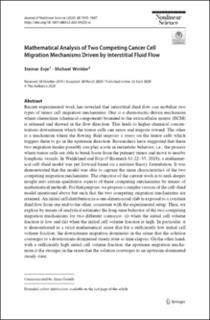| dc.contributor.author | Evje, Steinar | |
| dc.contributor.author | Winkler, Michael | |
| dc.date.accessioned | 2021-02-22T10:21:38Z | |
| dc.date.available | 2021-02-22T10:21:38Z | |
| dc.date.created | 2020-04-22T15:06:40Z | |
| dc.date.issued | 2020-04 | |
| dc.identifier.citation | Evje, S., Winkler, M. (2020) Mathematical Analysis of Two Competing Cancer Cell Migration Mechanisms Driven by Interstitial Fluid Flow. Journal of nonlinear science, 30 | en_US |
| dc.identifier.issn | 0938-8974 | |
| dc.identifier.uri | https://hdl.handle.net/11250/2729443 | |
| dc.description.abstract | Recent experimental work has revealed that interstitial fluid flow can mobilize two types of tumor cell migration mechanisms. One is a chemotactic-driven mechanism where chemokine (chemical component) bounded to the extracellular matrix (ECM) is released and skewed in the flow direction. This leads to higher chemical concentrations downstream which the tumor cells can sense and migrate toward. The other is a mechanism where the flowing fluid imposes a stress on the tumor cells which triggers them to go in the upstream direction. Researchers have suggested that these two migration modes possibly can play a role in metastatic behavior, i.e., the process where tumor cells are able to break loose from the primary tumor and move to nearby lymphatic vessels. In Waldeland and Evje (J Biomech 81:22–35, 2018), a mathematical cell–fluid model was put forward based on a mixture theory formulation. It was demonstrated that the model was able to capture the main characteristics of the two competing migration mechanisms. The objective of the current work is to seek deeper insight into certain qualitative aspects of these competing mechanisms by means of mathematical methods. For that purpose, we propose a simpler version of the cell–fluid model mentioned above but such that the two competing migration mechanisms are retained. An initial cell distribution in a one-dimensional slab is exposed to a constant fluid flow from one end to the other, consistent with the experimental setup. Then, we explore by means of analytical estimates the long-time behavior of the two competing migration mechanisms for two different scenarios: (i) when the initial cell volume fraction is low and (ii) when the initial cell volume fraction is high. In particular, it is demonstrated in a strict mathematical sense that for a sufficiently low initial cell volume fraction, the downstream migration dominates in the sense that the solution converges to a downstream-dominated steady state as time elapses. On the other hand, with a sufficiently high initial cell volume fraction, the upstream migration mechanism is the stronger in the sense that the solution converges to an upstream-dominated steady state. | en_US |
| dc.language.iso | eng | en_US |
| dc.publisher | Springer Nature Switzerland AG | en_US |
| dc.rights | Navngivelse 4.0 Internasjonal | * |
| dc.rights.uri | http://creativecommons.org/licenses/by/4.0/deed.no | * |
| dc.subject | kreftceller | en_US |
| dc.subject | matematisk analyse | en_US |
| dc.title | Mathematical Analysis of Two Competing Cancer Cell Migration Mechanisms Driven by Interstitial Fluid Flow | en_US |
| dc.type | Peer reviewed | en_US |
| dc.type | Journal article | en_US |
| dc.description.version | publishedVersion | en_US |
| dc.rights.holder | © The Author(s) 2020 | en_US |
| dc.subject.nsi | VDP::Matematikk og Naturvitenskap: 400::Matematikk: 410 | en_US |
| dc.source.pagenumber | 1809–1847 | en_US |
| dc.source.volume | 30 | en_US |
| dc.source.journal | Journal of nonlinear science | en_US |
| dc.identifier.doi | 10.1007/s00332-020-09625-w | |
| dc.identifier.cristin | 1807538 | |
| cristin.ispublished | true | |
| cristin.fulltext | original | |
| cristin.qualitycode | 1 | |

